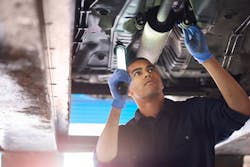Maintenance Management Lessons From Crime Scene Investigations
Who doesn’t like a good murder mystery, especially when a crime scene investigator becomes involved and helps detectives get to the bottom of the case? The investigator processes the crime scene through an organized approach and examines the evidence for clues. Then, like Sherlock Holmes – the fictitious detective who practiced forensic science and criminal profiling years ahead of the rest of the world – employs deductive reasoning to reach a conclusion about who done it.
The entire crime scene investigation (CSI) is accomplished within one television program, movie or novel. Impressive, but absurd.
In reality, solving a crime – especially a gruesome murder – is an effort that takes a considerable amount of time and labor. Ask any police detective if they can get an autopsy or DNA test “fast tracked” and the results returned within a one-hour CSI television program. After they stop laughing, they will emphatically tell you: “No way.”
Be that as it may, for vehicle maintenance personnel, there are lessons to be learned from the methods used within those CSI television shows, movies and novels. When a technician needs to get to the bottom of a vehicle malfunction, he must be a skilled investigator. Sometimes this includes recreating and examination the events leading up to a fault of malfunction. Much like a crime scene investigators, a technician’s work is all about finding clues, connecting the dots and providing clear documentation of their methodology.
Responsibilities
Consider the occupation of crime scene investigator. They spend a great deal of their time in the field, working to methodically collect evidence from the scene of the crime. Among other duties and responsibilities, their job involves:
- Securing the crime scene.
- Once the scene is secure, taking measurements.
- Sketching and diagraming the scene in detail.
- Photographing the entire crime scene.
- Documenting the evidence collected from the scene (location, nature, etc.).
- Labeling all evidence and packaging it properly for preservation.
- Attending autopsies, taking photographs and taking notes.
- Writing detailed reports on evidence collection procedures and on conclusions based on the evidence.
- Communicating with prosecutors and testifying in court when an arrest is made.
Objectives
There are a number of key objectives to a thorough crime scene investigation that can also pertain to vehicle maintenance. These include:
- Reconstructing the crime.
- Determining the sequence of the events that led up to the crime.
- Establishing the mode of operation of the perpetrator(s) of the crime.
- Uncovering the motive for the crime.
- Determining everything the perpetrator(s) may have done at the crime scene.
- Recovering and processing all physical evidence at the scene.
Properly processing a crime scenes involves an organized approach using a sequence of established and excepted duties and protocols. There are three fundamental stages to successful crime scene processing:
- Scene recognition.
- Scene documentation.
- Evidence collection.
All of the duties and responsibilities of a crime scene investigator can be adapted by vehicle maintenance personnel to help to identify the reason – a condition or a chain of events – that resulted in a component failure or a vehicle breakdown.
At the Scene
The first step to the “crime scene” investigation of a component failure/vehicle breakdown is to secure the scene, where possible. Then, take a systematic approach to “processing” scene. Gather all of the necessary information about the incident and make an initial examination of the failure/breakdown.
Note the date, time and location of the incident; the driver’s name and terminal; and the vehicle number/ID, year, make, model and mileage. Comprehensively document the “crime scene” with a series of photographs depicting the vehicle and its problem.
As has been pointed out within numerous articles in Fleet Maintenance: “A picture is worth a thousand words.”
Next, search for “items of evidence” not observed during the initial examination. This could be fluid leaks, small parts and pieces of metal and/or plastic on the ground, excessive wear, etc. These things, and their location, should be noted and photographed as well.
All of the evidence then needs to be collected, or as they say on CSI programs: “bagged and tagged.” These items can be examined in detail at a later time, if necessary.
The subsequent step is to thoroughly interview the driver to learn what happened prior to, during and immediately after the component failure/vehicle breakdown.
Review Data
The CSI now shifts to “lab” work. Vehicle history and repair records are invaluable in the investigation of a component failure or a vehicle breakdown. Scrutinize these records for long-term trends in equipment operation and causes for downtime, looking for answers to such questions as:
- Has the problem happened before?
- If so, what caused it on that occasion?
- How was it corrected each time?
- Did the fix work? If not, why?
A wealth of insight can be found by analyzing the information from a vehicle that has telematics systems that monitor, record and store such things as operational functions, status, location, movement, driver behavior, etc.
Then there is the broken or failed component and the vehicle. Examine these to determine why the component broke/failed, as well as how it broke/failed. This will help discover the actual cause of the failure/breakdown.
Find the Culprit
At this point in the investigation, “walk away” from the “case” and take some time off, advise veteran crime scene investigators and detectives. Return with a fresh set of eyes and carefully go over all the evidence and information, and your analysis of this. Then, employ logic to determine who done it.
With each CSI, you will gain greater insight into your maintenance operation. That, in turn, will enable you to take the necessary corrective actions to avoid repeat “crimes” and improve vehicle reliability. This helps to reduce costly repairs and downtime.
About the Author

